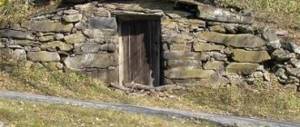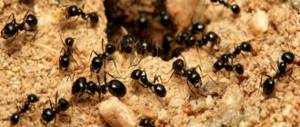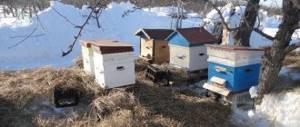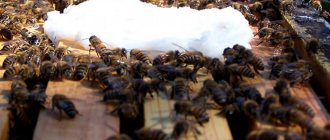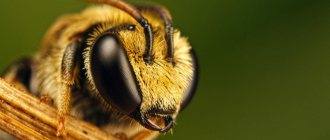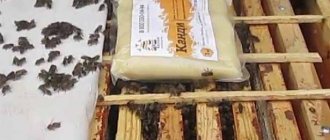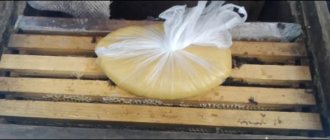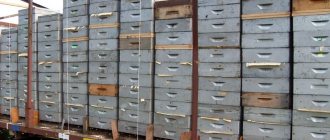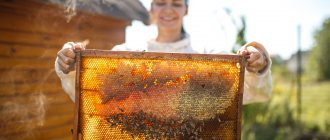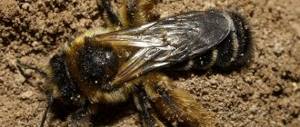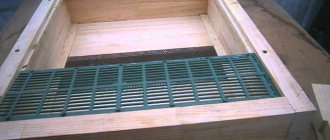Wintering of nucs and weak bee colonies
It is important for beekeepers to have spare queen bees in the apiary. As a standard, an apiary should have 10 queen bees for every 100 bee colonies. It is especially important to have a supply of fertile queen bees in early spring. In more northern areas, where the beekeeping season is short and there is no time to breed your own queen bees, and purchased ones may be of poor quality, the supply of queen bees can reach 100%, in order to quickly make layering in early spring and have time to build them up before the main honey flow and get a marketable one. honey. Moreover, the queen bees obtained in August are of very high quality, much better than those obtained in early spring. After a prolonged honey harvest or if the season was unsuccessful, then by autumn there are many weak bee colonies left in the apiary, which you really don’t want to lose. Therefore, beekeepers are always faced with the task of how to organize the wintering of nucs and weak bee colonies.
There are many ways to organize the wintering of nucs and weak bee colonies in an apiary. Some methods have been used by beekeepers for a long time, others are just beginning to be used. Therefore, we will consider what methods there are for wintering nucs and weak bee colonies.
Traditional methods of wintering nucs and weak bee colonies
It is traditionally believed that a nucleus containing half a kilogram of bees can go into winter, which corresponds to two Dadan frames or three frames per Ruth size. If there are few bees about the nucleus, the nucleus is strengthened before wintering at the expense of disbanded bee colonies. It should also be taken into account that weak bee colonies or nucs consume much more food in winter than strong bee colonies, so it is necessary to pay attention to the fact that the nucs overwinter on full copper frames, and all the food is above the club of bees, and you also need to understand that closer to spring They will definitely have to be fed with candy. To prepare winter food for nucs and weak bee colonies, two methods are used: • the first method is to place low-copper frames with the cells opened with a roller through a guard board, as a result of which the bees bring honey from the low-copper frames, into the frames on which they will winter and completely fill all the cells honey. • the second method is to feed the bees with inverted syrup, which is given to the bees in small portions so that they completely fill all the cells. Feeding the bees with inverted sugar syrup will allow the bees to wear out less before wintering.
Method for overwintering nucs and weak bee colonies in a sunbed hive
The traditional way of overwintering nuclei and weak bee colonies in an apiary equipped with beehive beds is that the nucleus is placed through a blind partition in the hive bed next to a strong bee colony, so that the nucleus or weak bee colony uses part of the heat generated by the strong bee colony. A nucleus or a weak bee colony is never placed in a hive with a weak bee colony.
Method for wintering nuclei and weak bee colonies in the Dadan hive
Body 12 of the dadan frame hive is marked out so that there are three to four compartments and cuts are made so that partitions can be inserted. Partitions are made from different materials; plywood (4 mm), chipboard, and foam plastic may be suitable. The partitions are made in such a way that the bees cannot get from one compartment to another, either along the bottom or by climbing over the top of the partition; to do this, a block with a cut is placed on top. Round entrances are made in each compartment; such entrances can be conveniently and quickly cut with a drill in any housing, and in the summer the entrances can be plugged with an ordinary stopper from a wine bottle, and subsequently used for an ordinary bee colony at honey collection. It should be taken into account that the hive body will only fit 11 frames with bees. Nuclei and weak bee colonies of 2 to 5 frames of bees, which are very well maintained by bees, are transferred to prepared and separated by partitions compartments of the Dadana hive. To do this, in advance in the fall, all unnecessary frames are removed from the cores and weak bee colonies and fed, so that the bees do not crawl over the frames, but are concentrated on the smallest number of full-copper frames. Even if the bees hang a little from the frames, it’s okay, by winter the number of bees will still decrease further. The frames from the nuclei and weak bee colonies are transferred to a specially prepared housing when it gets colder and the bees stop flying. Thus, in one body of the Dadana hive, in three or four compartments, there will be three or four cores with a large number of bees. This will allow them to form one large club of bees despite the partitions. The bees feel the warmth and strive to form a common club near the warm partition. Nuclei and weak bee colonies winter normally by mutually warming each other. As a rule, they try to bring such hives into winter hives, omshaniks, sheds, garages and other suitable premises. But if the winter is short, they can spend the winter outside. Closer to spring, nucs and weak bee colonies are fed with candy.
Method for wintering nuclei and weak bee colonies in multi-hull hives and Ruta hives
If the apiary is equipped with multi-hull hives or rue hives, wintering of the nucs and weak bee colonies is organized in the following way. The main bee colonies overwinter in two buildings, the third building above them goes into the winter or two - three nuclei or a weak bee colony and a nucleus. At the same time, the hive is brought into the omshanik. In order to avoid excessive dampness in the third building, a gap of half a centimeter is left between the second and third buildings; this is enough for moist air to escape from the lower buildings.
Wintering of nucs and weak bee colonies in 6 frame hives PPU on a Ruta frame
Recently, hives made from polyurethane foam have come into fashion. In a 6-frame core hive made of polyurethane foam, two queen bees can easily overwinter in 3 frame cores. Since the hive is warm, the bees in it consume less winter food in winter. Due to the fact that the PU hive is warm, the queen bee overwintered in it from the 3rd frame nucleus creates a 6th frame package per Rutov frame by May 10th. When organizing wintering in such a hive, two cores with queens, each with three frames, separated by partitions, overwinter. In winter, the nucleus needs to be fed; a kilogram of candy placed on the frame in winter is quite enough for winter nutrition and for spring development. More details Work with a 6-frame core hive made of polyurethane foam for a 230 mm frame.
Video wintering of nucs and weak bee colonies
Happy wintering to all beekeepers!
More materials about preparing bees for wintering and wintering bees
What is a nucleus
Many beekeepers are familiar with this situation when not only worker bees, but also queen bees die during wintering. In order to preserve the brood, a nucleus is needed. Moreover, a properly assembled mini-hive will help reduce waste that occurs in early winter and is associated with an increase in the number of working families in the apiary.
Construction evidence
In beekeeping, such mini hives or nucs are more often used to preserve weak families and young, recently born bees. This is important so that with the arrival of spring you do not have to look for new queens, losing the unique opportunity of the first bribe. Therefore, such small hives are an ideal solution for the active development of a young family.
Experienced beekeepers have a lot of ideas in their arsenal on how to create nucs for bees with their own hands and use them to populate a young colony, and in the spring get strong worker bees and an optimal brood. To create such a small hive, you can use an old one, but this is not entirely profitable.
Therefore, it is better to create a new home from scrap materials. This does not mean that everything that turns out to be unnecessary will be used. The bees will simply chew up loose building material of low quality and get out. Therefore it is beneficial to use:
- high-quality plywood sheets;
- planed boards;
- chipboard sheets;
- polystyrene foam or polystyrene foam as insulation;
- frames, no more than 2 pieces for brood and 2 for food, one frame at a time.
The house is assembled in any way that seems convenient. The end result looks like a small square or rectangular shaped hive. For example, parameters 405x600 mm are a classic option that looks approximately the same as in the photo.
It can be assembled by a beekeeper who has no carpentry experience. You can use the provided drawing or create your own project.
To build the core you will need strong, planed boards. The bees simply chew through the loose material.
- From the prepared boards, using the drawing parameters, assemble the body.
- Place a sheet of plywood of the appropriate size at the bottom of the box.
- Create a taphole (up to 15 mm) and a ventilation hole.
- Make legs and attach the structure to them.
The presented diagram shows how to place frames in a new home.
Advantages
As a result of step-by-step actions, the beekeeper manages to assemble a new simple house and prepare temporary housing for a young family. Not so long ago, beekeepers used conventional hives to raise families, simply dividing them into sections. Today, many have abandoned this, appreciating the advantages of the core:
- high degree of survival of queens during wintering, due to effective heat conservation;
- the bee in such conditions is highly productive;
- a small hive has a ventilation system, which reduces the risk of infectious infection of young animals;
- It is advantageous to use cores for catching swarms or layering.
Move-in process
It is necessary to form a bee colony during swarming or during the main honey collection period. In this case, it is necessary to settle the cores after lunch.
The process of settling bees in a made hive may differ slightly depending on climatic conditions:
- In warm regions, two frames with food and one with brood are installed in the structure. One queen and 300-350 worker bees are laid;
- In regions with temperate and cold climates, one frame with food and two with brood are installed. At the same time, about five hundred worker bees are laid.
In the process of populating a homemade nucleus for bees, the brood is taken sealed, and the amount of food should not be less than two kilograms. The installed brood combs must be constantly monitored. When they become empty, they must be replaced with new ones. This must be done before the uterus begins its egg-laying period.
Nucleus for wintering queens
A queen that has overwintered is considered truly strong.
By wintering, the resulting bee colony should grow to 4-5 frames. If the bee colony has not had time to grow, then you can place two bee families in the nucleus, separating them with a blank partition. Each family must have a separate entrance, located opposite to the other. Thus, bee colonies, being in the same nucleus, will warm each other up during wintering. But we must remember that each family needs at least 7 kg of honey for the winter. The air temperature in the room where the cores will be located during the winter period should not be lower than -2 -6 degrees. On the coldest days of winter, for example during Epiphany frosts, you can remove the nucleus with bees to a warmer room for several days.
Buy Kalinka hives from the manufacturer of wooden hives for bees in the Beekeeping store. You can also purchase bee packages, foundation, frames for hives, honey extractors, beekeeping suits, smokers, chisels, and preparations.
Related articles:
- Ukrainian steppe bee
- Honey collection. Types, periods and methods
- How to prevent bees from swarming
- Dowsing in beekeeping. Application of dowsing in the apiary.
- Honey productivity of plants
Share with friends:
